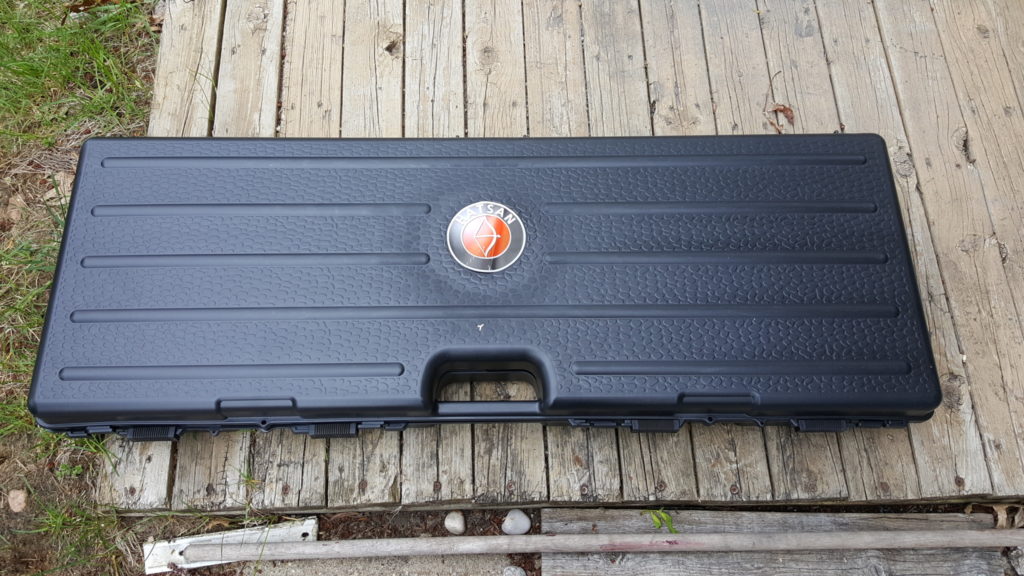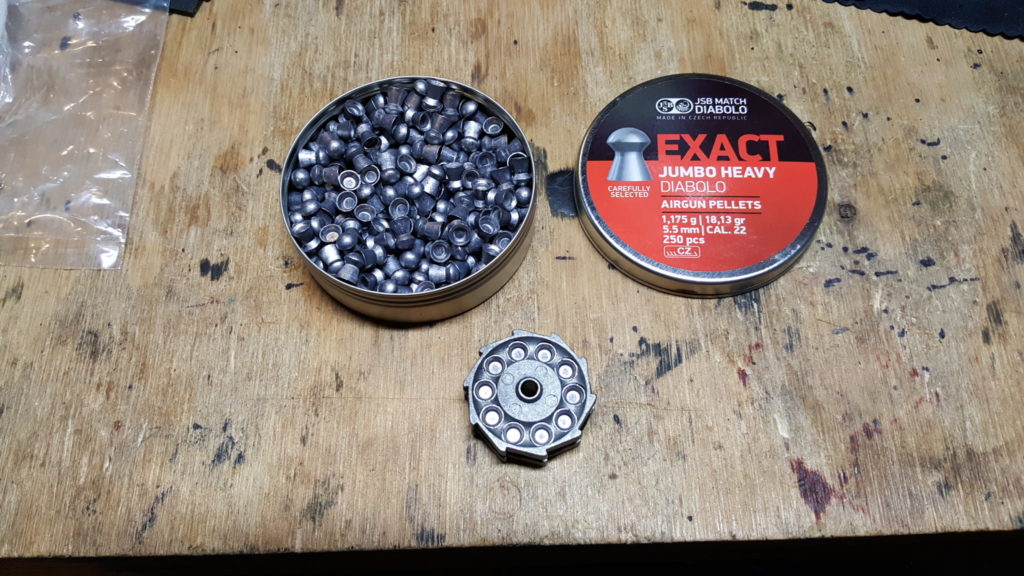
I’ve been using a RWS Diana 34P for pest control for two years and wanted to get something without the recoil / spring bounce, had plenty of power, was quiet and also had a quick follow up shot. To explain two points – a spring pistol air rifle has a rather bizarre recoil caused first by the spring triggering forward and then the pellet being pushed out the barrel. This requires a particular way of holding the rifle to be accurate wherein it can actually move. This is known as an artillery hold. The other issue has to do with the follow up shot. Now I got pretty good at taking a shot, whipping the 34P around while breaking the barrel open and using a pellet pen to insert the next round. However, that all takes time and you lose sight of whatever critter you are trying to get – in my case it comes down to tree squirrels, ground squirrels and rabbits.
So, a pre-charged pneumatic (PCP) seemed to make a lot of sense to me and the first hurdle was to figure out how to charge it in a rural area. After a bunch of reading, I decided to buy a Hill Mk4 hand pump so that part was covered (click here for my review of it). The next question became, which PCP rifle to get. On the low priced, quiet, effective and very popular side was the Benjamin Marauder. The only reason I did not buy it was that I wanted something smaller. I considered the pistol version of the Marauder but wanted a longer barrel to improve energy and accuracy. I must admit that I may get one or the other of those some day in the future.
What really caught my eye was the large selection of bullpup air rifles. I’ve always liked bullpups because they are relatively compact and balance well. There are a ton of very well rated bullpups including models from Vulcan, Kaliber, Taipan and FX. I also ran across two offerings from Hatsan – the BullBoss and the Gladius. They are very similar except the Gladius has an adjustable cheek rest, recoil pad for length of pull and vertical placement, power adjustment and the magazine carrier in the stock. The plus for the BullBoss is that it is 1.1 pounds lighter as a result. I opted for the Gladius due to the adjustability.
The Gladius comes in three calibers and two lengths. Long ago I switched from .177 to .22 for pest control and knew I wanted a .22. They have a .25 model but given that I already have a ton of different pellets to test from JSB, Crosman, and so forth, I didn’t want to add yet another caliber. I learned this long ago with firearms – each new caliber brings with it a lot of testing and learning just about what works and what does not. It’s not as simple as just buying one tin of pellets and you are good to go – you need to be able to test and see what is best for accuracy and even for a given application. Also, I went with the Long model – it has a barrel that is about 3″ longer and that gets you approximately an additional 100 Feet Per Second (FPS) and 7 more Foot Pounds of Energy (FPE).
I went ahead and bought the Gladius due to the adjustable stock and power settings. I’m glad I did because I really like to get the stock just right so that when I bring the rifle to bear the scope is just where I want it to be to get a full sight picture and have a consistent cheek weld. What is also nice about the Gladius is that it comes with a fitted hard case and four magazines total.
So the rifle showed up and I immediately mounted the Hawke 4-12×50 Mil Dot AO scope and took a couple of pictures. I’ll do another blog post about the scope and rings later but you get the idea.


As a side note, guys reported that when you receive it, you can’t tell which side of the case is the top. You know what? They are right. It was pure luck that I opened mine top up. I took a silver sharpie and wrote a small stylized “T” on the top so I could find it going forward.

Now another thing I like about the Gladius is that the pressure cylinder can be swapped while under pressure. I had seriously debated how to quickly charge the rifle if I needed to. Actual PCP tanks are expensive and the spare cylinders are only $159. Interesting enough, if you look at the case above, it has a cut out for a spare cylinder under the rifle. Right now, I’m debating whether to use that for a tanks or a Lead Dust Collector (LDC) which is airgun speak for a moderator, which would be in addition to the stock suppressor that is integral with the shroud. Out of the box, the Hatsan comes with the “probe” you will need to pump air into the cylinder. It screwed right onto my Hill Mk4 pump so there were no additional adapter fees. Here is the cylinder with Hill pump:

This is the end that screws into the rifle. The supports are nicely done and guide it into position without any trickery needed.

This is the fill port. The cylinder’s gauge is on the end and graduated in bars. The cylinder and rifle are rated for up to 200 bar, which is 2900.75 PSI.

In the following photo you can see the power selector, thje empty breach where the brass rod is and the magazine locking lever just forward of that. Note, to turn the power knob, you need to push the release button on the other side to push the knob out away from a set screw that prevents it from accidentally turning.

I find the safety really easy to use. You simply slide the blade forward with your trigger finger and you are ready to go. I appreciate things you can do by feel without having to fumble around and look. The Gladius has the Hatsan Quattro trigger and you can adjust it. I’m just using it as is right now. There is a long pull but you can feel the resistance increase before the trigger breaks with not too bad of a pull. I’ll play with it at some point.

Here you can see the adjustable buttpad and spare mags in their carriers. You undo the screw with the supplied screw driver and pull it out however far you want. I just needed to pull it out a bit.

I ran two cleaning patches down the bore to remove crud. The first one had dirt and oil on it. The second was much better.
I then loaded up a magazine with 10 JSB Exact Jumbo Diablo 18.13gr pellets and loaded the magazine into the rifle. You load from the back (the first photo) and seat the pellets all the way. I then flipped it over so you can see the front in the second photo.


Test firing was from 30 feet using my weighted MTM K-Zone stand

I got excited and shot 20-30 pellets before I realized I didn’t take any photos. On power level 6 it was loud. I’d heard to try 3 and 4. I started with 4 and got it down to about 1/2″ groups. I would shoot 4-5 pellets and then pump up the rifle and then do it again. The below is on power setting three which is fairly quiet (not great but good enough) and it had enough power to take out a rabbit and two tree squirrels at 30-45 feet. The following photo is at the end of sighting the rifle in. I’d stuck new Splatterburst stickers on my target and was three bullseyes with three shots. That was good enough for me. In a future post, I’ll do more groups and post them.

So, this is my first take. I like the rifle. It’s heavy but that works for me because the weight of the rifle absorbs my tremor. Accuracy sure seems solid. Next up on my to-do list is to install Huma regulators on both of my air cylinders and to get an additional moderator to quiet it down a bit more. I’ll get to the trigger some time but it is good enough for now.
Short answer – I like it. If I had it to do over, I would have waited on the spare cylinder and the regulators and bought an additional LDC instead to quiet it down a bit more. No big regrets for sure – I’m just very impressed with what this is doing out of the box is all. The pump is also way easier than I expected too – kudos to Hatsan for a fine rifle and Hill on a very fine air pump.
January 27, 2018 Update: I am very happy with this rifle. It hits harder than any air rifle I have ever owned. The accuracy is great and I have no problem taking care of pests. The Hawke scope is holding zero also. Note, the picatinny rings have worked great. What I have come to realize is that Hatsan made a hybrid rail such that the little airgun dovetail rings will work or Picatinny rings. The rifle really likes JSB Jumbo Exact 18.3 grain pellets, a power setting of four and the pressure between 160-190 BAR if unregulated.
March 11, 2020 Update: Still going strong. No problems.
If you find this post useful, please share the link on Facebook, with your friends, etc. Your support is much appreciated and if you have any feedback, please email me at in**@*********ps.com. Please note that for links to other websites, we are only paid if there is an affiliate program such as Avantlink, Impact, Amazon and eBay and only if you purchase something. If you’d like to directly contribute towards our continued reporting, please visit our funding page.
